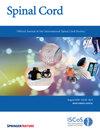Empowering lives of people with SCI: unlocking the transformative potential of the World Health Assembly’s resolution on rehabilitation – the 2024 ISCoS lecture
IF 2.2
4区 医学
Q3 CLINICAL NEUROLOGY
引用次数: 0
Abstract
Narrative review. To summarize the key messages presented during the ISCoS lecture at the 63rd ISCoS Annual Meeting, focusing on the global rehabilitation landscape, particularly regarding spinal cord injury. Not applicable. The review starts by providing an overview of the World Health Organization (WHO) Rehabilitation 2030 initiative. It then describes how to bridge evidence with rehabilitation practice and the role of CochraneRehab. Rehabilitation is contextualized within Rehabilitation 2030 and the World Health Assembly resolution on strengthening rehabilitation in health systems, highlighting significant policy shifts and technical tools developed by the WHO. The increase in global rehabilitation needs is outlined, citing estimates that nearly one-third of the global population could benefit from rehabilitation services. The role of CochraneRehab is discussed as a catalyst for enhancing primary research quality, evidence synthesis, and knowledge dissemination in rehabilitation. The review advocates for alternative study designs and innovative methodologies, including big data and artificial intelligence, to address persistent evidence gaps in spinal cord injury. In this pivotal moment for global rehabilitation, all stakeholders must unite to implement the WHA resolution and advocate for quality rehabilitation services in health systems and high-quality, innovative research methods to address evidence gaps like those in spinal cord injury care. This requires generating and disseminating evidence-based interventions and overcoming the inherent challenges of implementing these changes in everyday clinical practice.增强脊髓损伤患者的生活能力:释放世界卫生大会关于康复的决议的变革潜力- 2024年ISCoS讲座。
研究设计:叙述性回顾。目的:总结在第63届ISCoS年会上ISCoS演讲期间提出的关键信息,重点关注全球康复前景,特别是关于脊髓损伤。设置:不适用。方法:审查首先概述了世界卫生组织(世卫组织)2030年康复倡议。然后,它描述了如何将证据与康复实践和CochraneRehab的作用联系起来。结果:康复是在《2030年康复》和世界卫生大会关于加强卫生系统康复的决议的背景下进行的,突出了世卫组织制定的重大政策转变和技术工具。报告概述了全球康复需求的增长,并引用了全球近三分之一的人口可能受益于康复服务的估计。本文讨论了CochraneRehab作为提高初级研究质量、证据合成和康复知识传播的催化剂的作用。该综述倡导采用替代研究设计和创新方法,包括大数据和人工智能,以解决脊髓损伤中持续存在的证据缺口。结论:在全球康复的这一关键时刻,所有利益攸关方必须团结起来,执行世界卫生大会决议,倡导卫生系统提供高质量的康复服务,并采用高质量的创新研究方法,以解决脊髓损伤护理等方面的证据差距。这需要产生和传播基于证据的干预措施,并克服在日常临床实践中实施这些变化的固有挑战。
本文章由计算机程序翻译,如有差异,请以英文原文为准。
求助全文
约1分钟内获得全文
求助全文
来源期刊

Spinal cord
医学-临床神经学
CiteScore
4.50
自引率
9.10%
发文量
142
审稿时长
2 months
期刊介绍:
Spinal Cord is a specialised, international journal that has been publishing spinal cord related manuscripts since 1963. It appears monthly, online and in print, and accepts contributions on spinal cord anatomy, physiology, management of injury and disease, and the quality of life and life circumstances of people with a spinal cord injury. Spinal Cord is multi-disciplinary and publishes contributions across the entire spectrum of research ranging from basic science to applied clinical research. It focuses on high quality original research, systematic reviews and narrative reviews.
Spinal Cord''s sister journal Spinal Cord Series and Cases: Clinical Management in Spinal Cord Disorders publishes high quality case reports, small case series, pilot and retrospective studies perspectives, Pulse survey articles, Point-couterpoint articles, correspondences and book reviews. It specialises in material that addresses all aspects of life for persons with spinal cord injuries or disorders. For more information, please see the aims and scope of Spinal Cord Series and Cases.
 求助内容:
求助内容: 应助结果提醒方式:
应助结果提醒方式:


